I went downstairs into Indianapolis Union Station and was spotted by Chris Parker, who had flown in yesterday. We walked out to the rental car and soon were on our way out of town for Illinois by way of the Indianapolis Motor Speedway on this rather dark and windy morning. We drove out of Indiana on Interstate 74 through some rain showers into Illinois then at Champaign, we visited a Walmart for some warmer clothes before going to Bob Evans Restaurant for a fantastic French Toast platter. On the road again, we proceeded to Interstate 57 South for a couple of miles to Interstate 72, which we took west to Monticello and exited onto Iron Horse Boulevard, which led us to the Monticello Railway Museum.
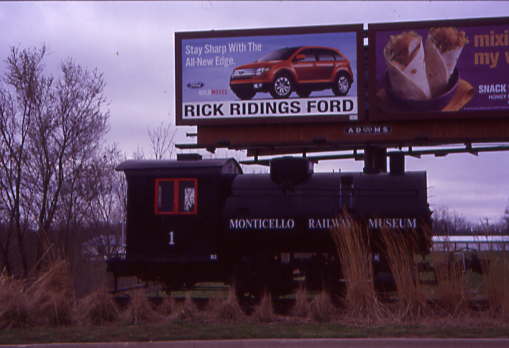
Out by the highway is Western Industrial Aggregates 0-4-0T 1 built by American Locomotive Company in 1924. This was the Museum's first piece of equipment and was acquired in 1966 from the Western Indiana Aggregate & Stone Company in Montezuma, Indiana and weighing 27 1/2 tons, this 0-4-0 came with a saddle tank. 1 ran from October 12th, 1972 until 1988.
At the sign, we turned right and followed the directions they sent me. We met someone who asked why we were there, then gave us directions to the steam shop.
Monticello Railway Museum HistoryThe Monticello Railway Museum is a not-for-profit educational organization founded in 1966 as "SPUR"; Society for the Perpetuation of Unretired Railfans. SPUR's goal at that time was to maintain and operate steam powered passenger train excursions. In 1969 the name was changed to the Monticello & Sangamon Valley Railroad Historical Society, Inc., and then, in 1982, the name was again changed to Monticello Railway Museum (MRM), which stands to this day.
The origins of the Monticello Railway Museum can be traced back February 1966, when the Chicago, Burlington and Quincy operated its last steam excursion out of St. Louis, Missouri. On board that trip were three steam-loving students from Illinois Wesleyan University in Bloomington, Illinois -- Ted Lemen, Bill Gillfillan and John Morris -- who were devastated to learn that the end of the steam program was coming. They decided that something needed to be done to save the program. During the trip, the three students walked up and down the train recruiting people to write to the CB&Q in hopes that they would change their mind and keep the program running.
By the end of the trip, 110 passengers had signed up promising to write the railroad. In addition, the three students had also collected 50 cents from each person, and used the $55 to charter the Society for the Perpetuation of Unretired Railfans (SPUR), with a mission of saving the CB&Q's steam program. Unfortunately, the efforts of SPUR to save the program ultimately failed, and the last CB&Q steam train ran in June 1966. Soon after, the group began to set their sights on a new project: owning their own steam locomotive and running their own excursions. SPUR began looking for a good place to run a steam train, and eventually chose a lightly-used branch line of the Illinois Central Railroad that ran between Le Roy and Sabina, Illinois in rural McLean County. However, upon discussing the plan with the Illinois Central, it was determined that the IC's requirements for running steam excursions on their property were too expensive and complicated.
After the plan to run on the IC was abandoned, the Illinois Pioneer Heritage Center in Monticello contacted SPUR and encouraged them to have their operation in Monticello. SPUR discovered that Monticello would be a great spot for their operation, as several miles of abandoned right-of-way from the Illinois Terminal interurban railway were available for purchase. Around this time, SPUR purchased their first steam locomotive, a tiny 0-4-0 switch engine, No. 1, that worked for many years at a quarry in Montezuma, Indiana. The engine was moved to Monticello in November 1966 and placed on a small section of track that SPUR members had constructed in the Illinois Pioneer Heritage Center's parking lot. Members quickly got to work restoring it to operating condition.
Over the next two years, more equipment was obtained by the museum including some former Wabash passenger cars. In 1967, SPUR purchased their second steam locomotive, former Southern Railway 2-8-0 No. 401, from a limestone quarry in Margerum, Alabama. In early 1969, efforts to acquire the Illinois Terminal right-of-way went into full swing, and in April of that year, SPUR renamed itself to the Monticello & Sangamon Valley Railway Historical Society. A few months later, a third steam locomotive, former Republic Steel 0-6-0 No. 191, was purchased. The acquisition of the abandoned Illinois Terminal right of way was completed in 1970, and efforts to rebuild the track began immediately. The little 0-4-0 that was kept in the Illinois Pioneer Heritage Center's lot was trucked to the new tracks, and ran for the first time on October 13, 1970.
Over the next couple of years, the M&SV continued to expand, acquiring more and more equipment for their collection and upgrading their tracks on the former IT right-of-way. A portion of a popcorn field adjacent to the museum's tracks was purchased for use as a yard to store the growing equipment collection. (Today, this site is known as Camp Creek Yard and is home to the museum's main yard, restoration facilities and locomotive shed.) While the museum's tracks were not connected to the national rail network, delivering equipment was relatively easy, as the Illinois Central operated a branch line that ran less than 100 feet west of the museum's track. New equipment arrivals to the museum would be brought in by the IC and "straight-railed" over to the museum's line, meaning that the IC's track would be dismantled, rebuilt to connect to the museum's, then disassembled again after the equipment had been delivered and returned to its original state.
Prior to 1972, the M&SV only operated trains for its members. This changed on Memorial Day of that year when steam locomotive No. 1 operated the first public excursion over the group's entire railroad. Locomotive No. 191 arrived in Monticello later that year and was operational by October 1972. Work continued on expanding the line north towards the village of White Heath. By 1980, two-and-a-half miles of track had been laid on the former Illinois Terminal right-of-way. Around the same time, the former Illinois Central depot from nearby DeLand was relocated to the M&SV's grounds and turned into a gift shop and place to purchase train tickets.
In 1982, the M&SV renamed themselves once again to the present-day Monticello Railway Museum. The museum continued to expand, and in 1987, MRM acquired 7.5 miles of the Illinois Central line that paralleled their original track. This acquisition allowed museum trains to reach downtown Monticello, which greatly increased the number of visitors and made accessing the museum easier as passengers could now board trains downtown and take them to the main museum site. A few months later, the former Wabash depot in downtown Monticello was relocated to the museum's Illinois Central tracks and today serves as MRM's Monticello depot. While the museum's original line on the Illinois Terminal right-of-way remains in place, trains normally traverse the former Illinois Central line to reach downtown Monticello.
Since then, the Monticello Railway Museum has grown to be one of the largest railroad museums in the area, and currently has over 100 pieces of historic railroad equipment in its collection. Steam locomotives No. 1 and 191 last operated in the 1980s before being placed on static display, but Southern No. 401 was returned to service in 2010 and is the pride and joy of the museum.
In recent years, the museum has been taking steps to make its operation even better. A historic locomotive turntable has been acquired along with several new locomotives, cars and cabooses. Other big plans are in the works to make the museum more exciting than ever. We hope that you will come join us to share our passion for all things trains.
Illinois Central Railroad RS3 704 built by American Locomotive Company in 1955 as Long Island Railroad 1559 in 1955. The Gettysburg Railroad renumbered it to 301, and then later sold it to the Maryland Midland Railroad. It is currently painted in Illinois Central Railroad livery as 704 for the 150th anniversary for that railroad.
We went inside the steam shop and met the workers before taking pictures of Southern Railway 2-8-0 401 under restoration. It was built by Baldwin Locomotive Works in December 1907 and was at the time a larger locomotive, built with simplicity in mind. This locomotive was purchased by the museum in 1967 from Alabama Asphaltic Limestone, in Margerum, Alabama. It was then shipped on a flat car to Decatur, Illinois, arriving there in January 1968. It was unloaded and stored at Decatur until October 1971, when it and 12 other pieces of equipment were moved by rail to the museum site. It was towed on its own wheels from Decatur to Monticello in 1971. From 1971 to 1995, the locomotive was on display in our collection of equipment, with occasional work being done to stabilize and prevent further deterioration to the locomotive.
Tennessee Central E8A 5764, ex. Massachusetts Bay Transportation Authority, ex. New York Central 4264 1968, nee Pennsylvania Railroad 5764 built by Electro-Motive Division in 1952. It pulled such passenger trains as the Pittsburgher, Cincinnati Limited, and most notably, the Broadway Limited. In 2004, it was sold again to a Monticello Railway Museum member.
Inside the steam shop. I decide to explore the museum's grounds on this very cold and strong wind blowing morning.
Illinois Central combine 892 built by Pullman in 1918. The 892 was sold to American Steel Foundries in 1947 for use as a brake test car for testing new passenger car trucks and brake systems. To that end, and among other modifications, the car was fitted with a glass floor over the wheels. This was used so truck and brake engineers could observe how well different truck and brake rigging systems worked.
Norfolk & Western bay window caboose 557530 built by New York, Chicago and St. Louis Railroad (Nickel Plate Road) as 430 in 1960. This style offers a better view for the conductor of their train than a cupola would.
Soo line wood caboose 99100 built by American Car & Foundry in 1910, privately owned.
Illinois Central Business Car 7 built by Pullman in 1917. This car was used alongside several other office cars owned by the Illinois Central to transport railroad executives, celebrities, politicians and other important passengers in style all over the IC's system and features a lounge area with comfortable seats, two bedrooms, restrooms, a dining room and a kitchen, making it a true "hotel on rails". When it was in regular service, it even had its own attendant to take care of the passengers.
Following retirement by the Illinois Central, 7 was sold into private ownership and for a time operated on the Wisconsin & Calumet Railroad out of Janesville, Wisconsin. It was acquired by a member of the Monticello Railway Museum in 1995 and was restored to operating condition soon after its arrival at the museum.
Canadian National Steam Generator 15421 built by Canadian National in 1956.
Illinois Central coach 2612 "Carondelet" built by Pullman-Standard in 1947 for use on streamlined Illinois Central passenger trains such as the City of New Orleans, Panama Limited and Green Diamond.
Illinois Central Railway Post Office and mail storage car 404 built by Pullman in 1918. This car was used to sort and deliver mail via train and is on display for visitors to explore. It was rebuilt in 1947 at the Illinois Central Burnside Shops.
Illinois Central caboose 9926 built by the railroad in 1950. This steel side caboose features a large sliding door on both sides and replaced wooden cabooses of previous decades. This caboose is privately owned.
Nickel Plate Road baggage car 356 built by Pullman in 1924.
Gulf, Mobile & Ohio wide-vision caboose 2954 built by International Car Company in 1968, is privately owned.
United Refrigerator Transport Company 26012 built by General American Transportation Corporation in the 1950's.
Wabash Railroad steel caboose 2824 built by the railroad at their Decatur, Illinois shops in 1949. It has been backdated to late Wabash exterior and interior arrangements by the Wabash Historical Society, and equipped with interior exhibits.
Wabash Railroad box car 82697 built by the railroad in 1941. This car was used for general merchandise and consisted of steel sides and a steel floor.
Illinois Central caboose 9831 built by Illinois Central at their Centralia Shops in 1941; this caboose was used in high-speed freight and local service throughout the railway's system.
A tank car and baggage car.
Illinois Central coach 2920 built by Pullman in 1925. This heavyweight coach is a typical day coach that would have been used on the "City of New Orleans". This car has comfortable reclining seats and is equipped with heat and air conditioning.
Illinois Central bridge crane X238 and tender X4352 built by Illinois Central. This flatcar-mounted steam crane carried a pile driver attachment. The 238 was coal-fired and capable of moving under its own power and was primarily used for driving piles for bridge construction. This particular crane is believed to have worked on the line now owned by the museum.
Illinois Central Jordan Spreader X9151 built by Jordan in 1929. This unique, but very versatile piece of equipment, was pushed by a locomotive that also supplied air for its controls. Its large wings spread out to clean and regulate ditches, ballast, and even plough snow.
Republic Steel 0-6-0 191 built by American Locomotive Company in 1916 as Central Steel Company (later Republic Steel) 3 in Massilion, Ohio. During its fifty years, it was re-numbered 191 then was sold to the dealer Preston Duffy & Son in Columbus, Ohio, then to J. David Conrad in 1969 and finally, to the museum that same year. 191 arrived at Monticello in 1971 and, after receiving an overhaul, it operated at the museum from October 1972 until 1987.
Green Bay & Western RS3u 308 built by American Locomotive Company in 1955.
Mississippi Eastern 4-6-0 303 built by Baldwin Locomotive Works in 1916, for the railway in Quitman, Mississippi. The railroad was chartered in 1903 to haul lumber felled from tracts of timber in Eastern Mississippi owned by the Mississippi Lumber Co. By October 1933, however, most of the timber had been cleared. The sawmill at Quitman shut down and the logging railroads were removed. After eighteen years at the Mississippi Eastern, the locomotive then began a long, drawn-out odyssey through the southern, eastern and mid-western United States.
In 1934, 303 was sold to the dealer Birmingham Rail & Equipment Company and then re-sold to the Lancaster & Chester Railway Company, in Lancaster, South Carolina, as 32. In 1946, it was bought by the Hampton & Branchville Railroad also in Lancaster, before being sold to Byron Andrews in 1963 to operate excursions as York Southern 1 on Maryland & Pennsylvania trackage out of York, Pennsylvania. George Hart's Rail Tours took over the running of excursions on the M&P in 1964, and Andrews' equipment, including 32, went into storage. 32 was then sold through a court sale in 1968 to Leveran & Sons Scrap Yards in York, Pennsylvania, who, in turn, sold it to Richard Jensen of Chicago, Illinois, in 1970. It was finally sold to William Latham of Rockford, Illinois, in July 1986, who donated it to the museum in 2000.
Chicago Transit Authority articulated coach 5003 built by St. Louis Car Company in 1948. It was a three-part articulated unit and this coach was numbered 53.
Ice, dry and mechanical refrigerator cars.
Wabash coach 1238 built by American Car and Foundry in 1927. It became Norfolk and Western 1807 and was repainted for use on their Chicago commuter train.
With this last picture, I walked back inside the steam shop to warm and there met Ron Berkman, who would give the two of us of tour of the engine shop and the car shops.
Canadian National FPA-4 6789 built by Montreal Locomotive Works in 1959. It spent its entire life pulling passenger trains through Canada first for Canadian National Railway, and then for VIA Rail. It was retired in 1989 and acquired in 1994 by a private owner. It is regularly used to haul the museum's passenger trains.
Illinois Central GP11 8733 built by General Motors Electro-Motive Diesel Division in 1958 as Illinois Central 9386, and was rebuilt at the Paducah Shops in Kentucky in 1980 as a GP11. The locomotive was donated by Canadian National- Illinois Central in 2001 and has been restored to operational condition.
Milwaukee Road NW2 1649 built by General Motors Electro-Motive Diesel Division in 1947. This locomotive worked across the Milwaukee Road system before being retired and sold to a private party in Rockford, Illinois. The locomotive was donated to and arrived at the museum in 2000. After arrival, an operational restoration was begun that was completed in late 2003.
The Chicago, Milwaukee St. Paul and Pacific emblem on the locomotive.
Wabash Railway F7A 1189 built by General Motors Electro-Motive Diesel Division in 1953. Number 1189 was the last F7A ordered by the Wabash and was the last built by General Motors Division, Ltd. at London, Ontario, and spent most of its operational time in Fort Erie, Ontario. Retired in 1979, 1189 was sent to Decatur, Illinois to be scrapped but was donated to the Museum by the Norfolk and Western in 1980. After arrival at the museum, much body work was done as well as required mechanical work to return the locomotive to service.
We then went inside the machine shop.
Interior view.
The wheel lathe. Next was the car shop and the fantastic collection of equipment that this museum owns. We thanked Ron for the excellent tour and I showed Chris the equipment outside.
This line of preserved items in the museum's collection.
Wabash caboose 2834 built by the railroad in 1949.
A caboose of unknown origin.
Bates and Rogers Locomotive Crane 11442 built by Industrial Brownhoist in 1944 and Norfolk & Western Bunk Car 527103 built by Norfolk & Western in 1965. Oil fired, the crane has a lifting capacity of up to 60,000 lbs and can move under its own power. This machine is currently used at the museum for heavy lifting jobs.
We walked back to the steam shop and thanked everyone there before we drove down Nelson Crossing station to see more of the museum's unique equipment.
A wig-wag signal.
Nelson Crossing Depot built in 1919 by the Illinois Central in Deland, Illinois.
Delaware & Hudson baggage car 405 built by American Car and Foundry in 1957 and sold to the Gulf, Mobile & Ohio Railroad in 1963. It currently houses exhibits on display where visitors can learn about railroad history.
Lincoln Sand & Gravel 44 ton switcher built by Davenport Locomotive Company in 1940 for Morrell Meatpacking in Ottumwa, Iowa. It is one of seven switchers built in this style 44-tonners of this style. It was sold to Lincoln Sand & Gravel, in Lincoln, Illinois and renumbered 44. Donated to the museum in 1975, it saw use until the late 1980s and early 1990s. 44 is currently on display at the museum.
Santa Fe six section-six roomettes-four bedroom sleeper "Pleasant Valley" built by Pullman Standard in 1942. This sleeping car was previously owned by the Illini Railroad Club as their "Chief Illini".
Illinois Central baggage car 518 built by American Car and Foundry in 1937. This car was used by the Railway Express Agency to transport mail and packages on Illinois Central trains.
Nickel Plate Road baggage car 329 built by Pullman in 1929 for baggage and Railway Express Agency use.
Illinois Central Railway Post Office and mail storage car 404 built by Pullman in 1918. This car was used to sort and deliver mail via train and is on display for visitors to explore. It was rebuilt in 1947 at the Illinois Central Burnside Shops.
Norfolk & Western caboose 555047 built by International Car Company in 1976 and was one of six cabooses in a final order by the N&W.
Another line of equipment, our last picture at the Monticello Railway Museum. Chris and I then drove into downtown Monticello and found the station.
The Monticello Wabash Railroad station built in 1889 and moved to its present location along the former Illinois Central tracks in 1987, and restored by the Monticello Depot Association. We drove south to US 36 which we took east and at Tuscola, found the end of a freight train.
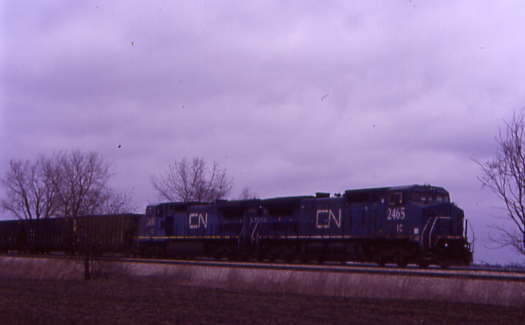
Canadian National 2465 South.
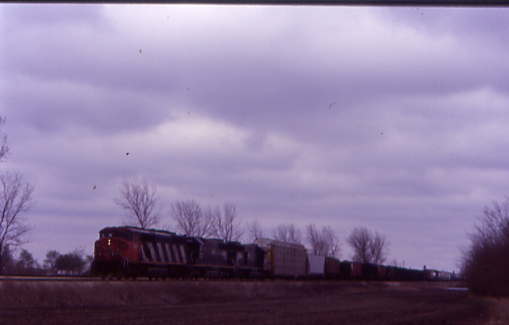
Canadian National 5559 North.
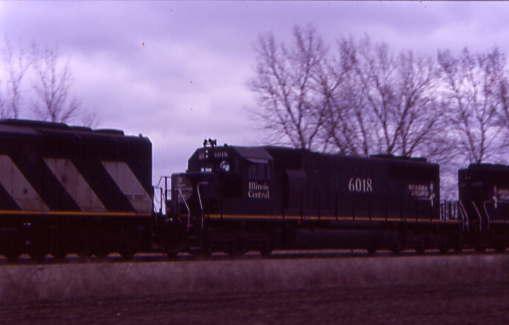
Illinois Central SD40A-2R 6018 built by Electro-Motive Division in 1969.
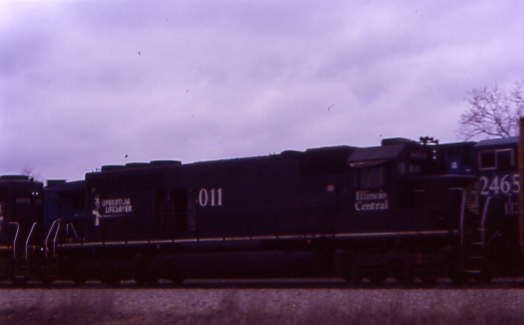
Illinois Central SD40A-2R 6011 built by Electro-Motive Division in 1969. We returned to US 36 and now needed petrol so stopped at the first station we could find on this cold windy midday.
Welcome to Chris!
Welcome to Chrisman, really! It was a good thing Chris Parker and Chris Guenzler were both in Chrisman this afternoon. Chris had gone into a café to get a hot drink and I finished refuelling the rental car then drove over to the restaurant to find him. We then walked out to the car and as we opened the doors, saw an older man collapse as he tried to get into his daughter's car so ran over to help. I went inside to call 911 while Chris assisted the daughter with her father. Chris covered him with his jacket while I learned from the daughter that her father had major heart problems. He had fallen flat onto his face and his glasses cut deeply into his face. Chris tried to get him up, but his legs would not hold him. The Volunteer Paramedics arrived, followed by the Volunteer Fire Department. What struck me as odd was that his blood pressure was never taken.
He was put onto a backboard and they almost took Chris' jacket with him. They thanked us for our help and we could not wait to get out of Chrisman so drove east to Indiana 83 in Indiana, which we took south toward Terre Haute and on the way there, we received a telephone message from Ray Burns of Trainweb.com, who gave us the phone number of a Moberly, Missouri radio station which wanted to interview me about my upcoming Million Rail Mile trip so I did a fifteen minute phone interview as we came into Terre Haute.
Chris stopped at a fast food restaurant before we continued south on US 41/150 to Sullivan then turned left onto Indiana 84 and as we approached Linton, stopped suddenly as we could not believe what we had just found.
The Ted Monier Parts and Salvage Scrap Yard. Inside we saw the former part of an Amtrak French Turbo Train.
Turbo power car 59.
Two Turbo coaches. This was a true surprise. Back in the car, we continued east to Bloomfield then turned south onto US 321 and at Loogootee, turned onto US 50 east to US 150, which took us to Indiana 54 and French Lick for our next train ride.
| RETURN TO THE MAIN PAGE |